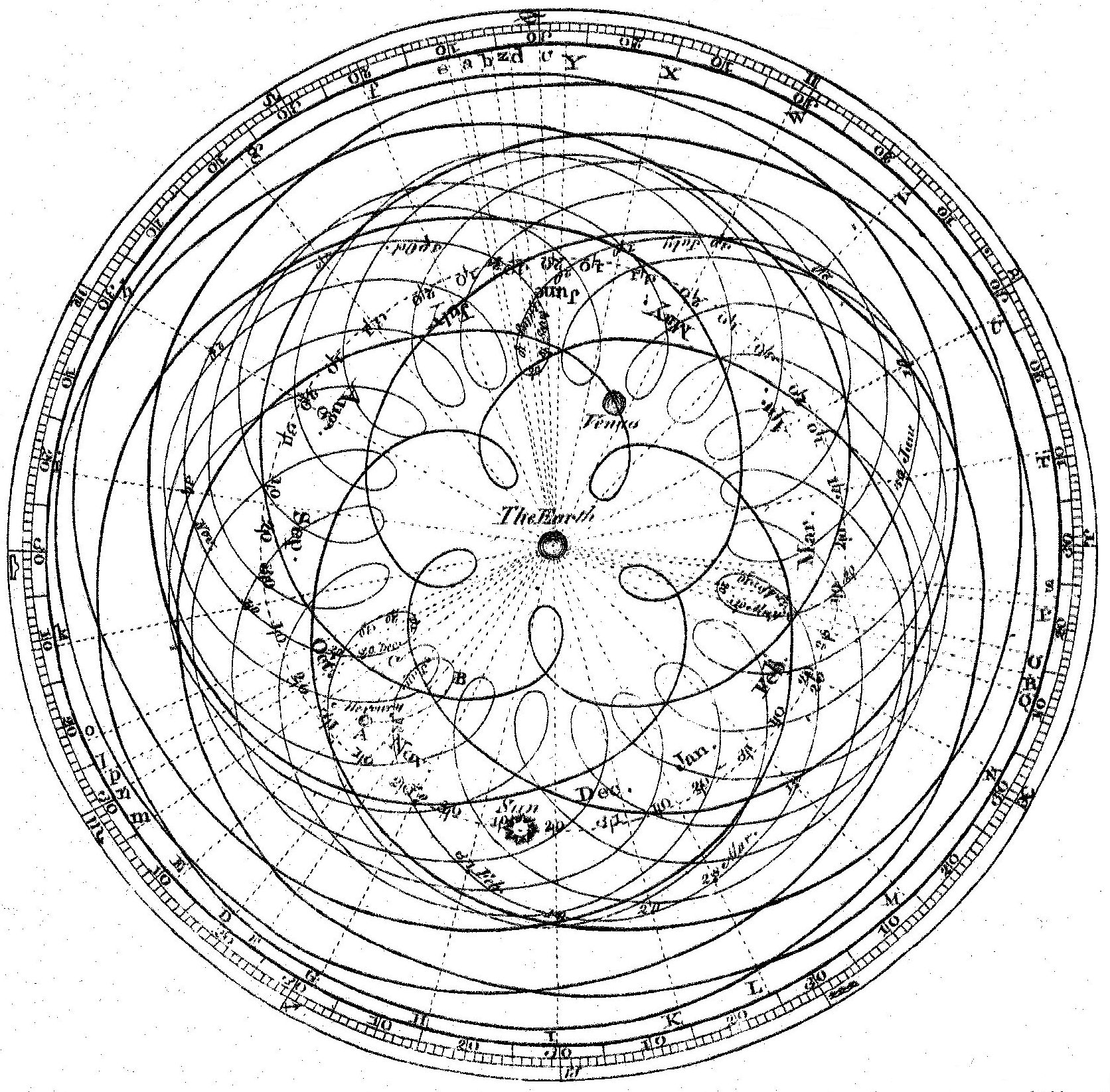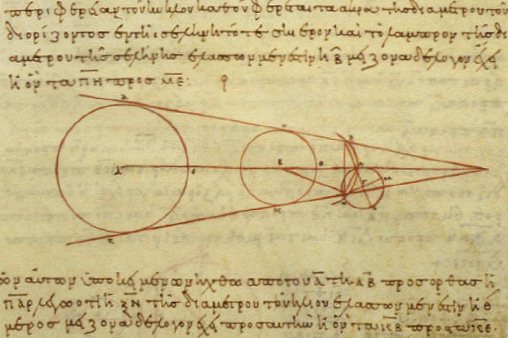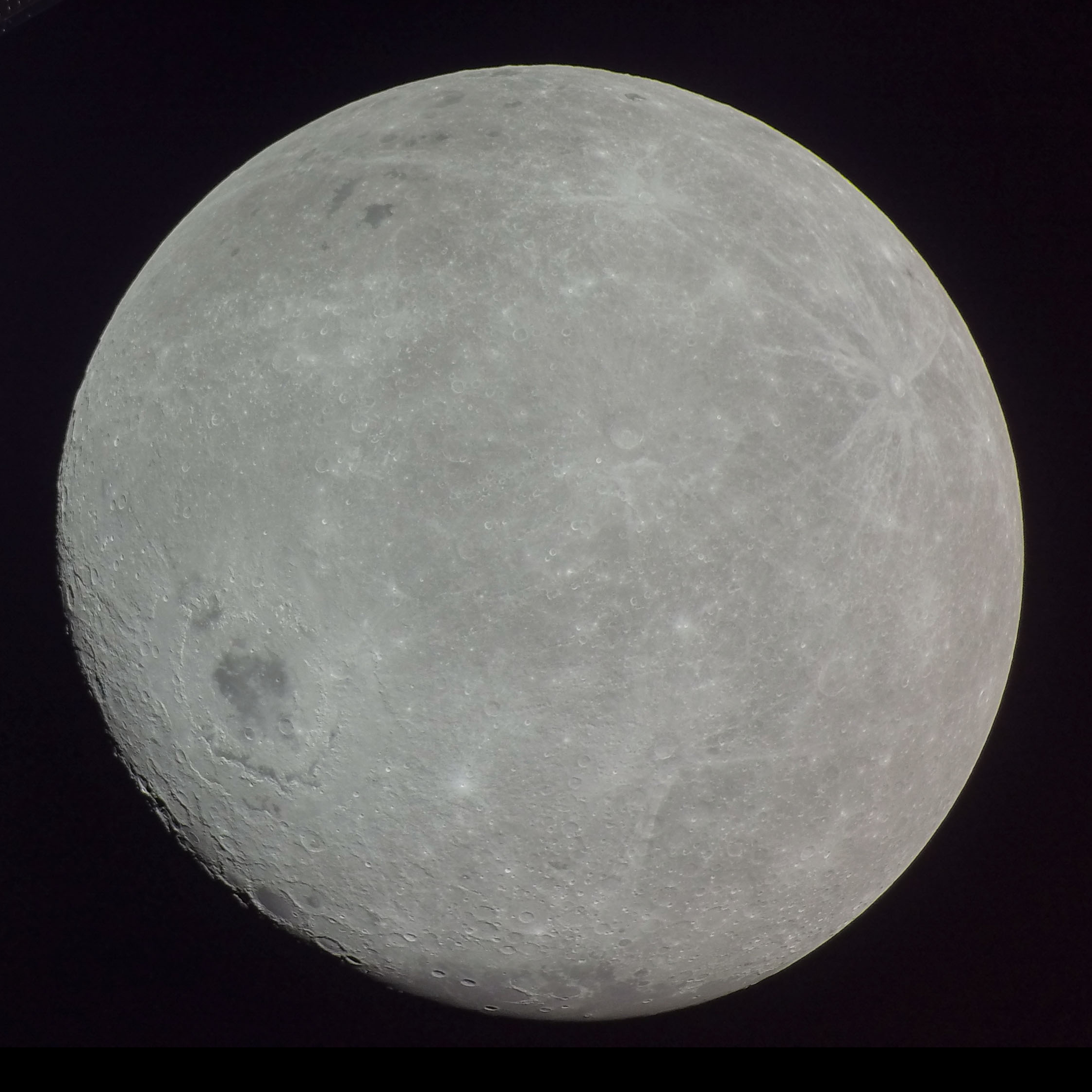|
Geocentric
In astronomy, the geocentric model (also known as geocentrism, often exemplified specifically by the Ptolemaic system) is a superseded description of the Universe with Earth at the center. Under most geocentric models, the Sun, Moon, stars, and planets all orbit Earth. The geocentric model was the predominant description of the cosmos in many European ancient civilizations, such as those of Aristotle in Classical Greece and Ptolemy in Roman Egypt, as well as during the Islamic Golden Age. Two observations supported the idea that Earth was the center of the Universe. First, from anywhere on Earth, the Sun appears to revolve around Earth once per day. While the Moon and the planets have their own motions, they also appear to revolve around Earth about once per day. The stars appeared to be fixed on a celestial sphere rotating once each day about an axis through the geographic poles of Earth. Second, Earth seems to be unmoving from the perspective of an earthbound observer; it ... [...More Info...] [...Related Items...] OR: [Wikipedia] [Google] [Baidu] |
Heliocentric Model
Heliocentrism (also known as the heliocentric model) is a superseded astronomical model in which the Earth and planets orbit around the Sun at the center of the universe. Historically, heliocentrism was opposed to geocentrism, which placed the Earth at the center. The notion that the Earth revolves around the Sun had been proposed as early as the 3rd century BC by Aristarchus of Samos, who had been influenced by a concept presented by Philolaus of Croton (c. 470 – 385 BC). In the 5th century BC the Greek philosophers Philolaus and Hicetas had the thought on different occasions that the Earth was spherical and revolving around a "mystical" central fire, and that this fire regulated the universe. In medieval Europe, however, Aristarchus' heliocentrism attracted little attention—possibly because of the loss of scientific works of the Hellenistic period. It was not until the 16th century that a mathematical model of a heliocentric system was presented by the Renaissance ... [...More Info...] [...Related Items...] OR: [Wikipedia] [Google] [Baidu] |
Fixed Stars
In astronomy, the fixed stars () are the luminary points, mainly stars, that appear not to move relative to one another against the darkness of the night sky in the background. This is in contrast to those lights visible to the naked eye, namely the planets and comets, which appear to move slowly among those "fixed" stars. The fixed stars include all the stars visible to the naked eye other than the Sun, as well as the faint band of the Milky Way. Due to their star-like appearance when viewed with the naked eye, the few visible individual nebulae and other deep-sky objects are also counted among the fixed stars. Approximately 6,000 stars are visible to the naked eye under optimal conditions. The term ''fixed stars'' is a misnomer because those celestial objects are not actually fixed with respect to one another or to Earth. Due to their immense distance from Earth, these objects appear to move so slowly in the sky that the change in their relative positions is nearly imperce ... [...More Info...] [...Related Items...] OR: [Wikipedia] [Google] [Baidu] |
Celestial Sphere
In astronomy and navigation, the celestial sphere is an abstract sphere that has an arbitrarily large radius and is concentric to Earth. All objects in the sky can be conceived as being projected upon the inner surface of the celestial sphere, which may be centered on Earth or the observer. If centered on the observer, half of the sphere would resemble a hemispherical screen over the observing location. The celestial sphere is a conceptual tool used in spherical astronomy to specify the position of an object in the sky without consideration of its linear distance from the observer. The celestial equator divides the celestial sphere into northern and southern hemispheres. Description Because astronomical objects are at such remote distances, casual observation of the sky offers no information on their actual distances. All celestial objects seem equally far away, as if fixed onto the inside of a sphere with a large but unknown radius, which appears to rotate westwa ... [...More Info...] [...Related Items...] OR: [Wikipedia] [Google] [Baidu] |
Aristarchus Of Samos
Aristarchus of Samos (; , ; ) was an ancient Greek astronomer and mathematician who presented the first known heliocentric model that placed the Sun at the center of the universe, with the Earth revolving around the Sun once a year and rotating about its axis once a day. He also supported the theory of Anaxagoras according to which the Sun was just another star. He likely moved to Alexandria, and he was a student of Strato of Lampsacus, who later became the third head of the Peripatetic school in Greece. According to Ptolemy, he observed the summer solstice of 280 BC. Along with his contributions to the heliocentric model, as reported by Vitruvius, he created two separate sundials: one that is a flat disc; and one hemispherical. Aristarchus estimated the sizes of the Sun and Moon as compared to Earth's size. He also estimated the distances from the Earth to the Sun and Moon. His estimate that the Sun was 7 times larger than Earth (while inaccurate by an order of magnitu ... [...More Info...] [...Related Items...] OR: [Wikipedia] [Google] [Baidu] |
Universe
The universe is all of space and time and their contents. It comprises all of existence, any fundamental interaction, physical process and physical constant, and therefore all forms of matter and energy, and the structures they form, from sub-atomic particles to entire Galaxy filament, galactic filaments. Since the early 20th century, the field of cosmology establishes that space and time emerged together at the Big Bang ago and that the Expansion of the universe, universe has been expanding since then. The observable universe, portion of the universe that can be seen by humans is approximately 93 billion light-years in diameter at present, but the total size of the universe is not known. Some of the earliest Timeline of cosmological theories, cosmological models of the universe were developed by ancient Greek philosophy, ancient Greek and Indian philosophy, Indian philosophers and were geocentric model, geocentric, placing Earth at the center. Over the centuries, more prec ... [...More Info...] [...Related Items...] OR: [Wikipedia] [Google] [Baidu] |
Orbit
In celestial mechanics, an orbit (also known as orbital revolution) is the curved trajectory of an object such as the trajectory of a planet around a star, or of a natural satellite around a planet, or of an artificial satellite around an object or position in space such as a planet, moon, asteroid, or Lagrange point. Normally, orbit refers to a regularly repeating trajectory, although it may also refer to a non-repeating trajectory. To a close approximation, planets and satellites follow elliptic orbits, with the center of mass being orbited at a focal point of the ellipse, as described by Kepler's laws of planetary motion. For most situations, orbital motion is adequately approximated by Newtonian mechanics, which explains gravity as a force obeying an inverse-square law. However, Albert Einstein's general theory of relativity, which accounts for gravity as due to curvature of spacetime, with orbits following geodesics, provides a more accurate calculation and u ... [...More Info...] [...Related Items...] OR: [Wikipedia] [Google] [Baidu] |
Johannes Kepler
Johannes Kepler (27 December 1571 – 15 November 1630) was a German astronomer, mathematician, astrologer, Natural philosophy, natural philosopher and writer on music. He is a key figure in the 17th-century Scientific Revolution, best known for his Kepler's laws of planetary motion, laws of planetary motion, and his books ''Astronomia nova'', ''Harmonice Mundi'', and ''Epitome Astronomiae Copernicanae'', influencing among others Isaac Newton, providing one of the foundations for his theory of Newton's law of universal gravitation, universal gravitation. The variety and impact of his work made Kepler one of the founders and fathers of modern astronomy, the scientific method, Natural science, natural and modern science. He has been described as the "father of science fiction" for his novel ''Somnium (novel), Somnium''. Kepler was a mathematics teacher at a seminary school in Graz, where he became an associate of Hans Ulrich von Eggenberg, Prince Hans Ulrich von Eggenberg. Lat ... [...More Info...] [...Related Items...] OR: [Wikipedia] [Google] [Baidu] |
Ptolemy
Claudius Ptolemy (; , ; ; – 160s/170s AD) was a Greco-Roman mathematician, astronomer, astrologer, geographer, and music theorist who wrote about a dozen scientific treatises, three of which were important to later Byzantine science, Byzantine, Islamic science, Islamic, and Science in the Renaissance, Western European science. The first was his astronomical treatise now known as the ''Almagest'', originally entitled ' (, ', ). The second is the ''Geography (Ptolemy), Geography'', which is a thorough discussion on maps and the geographic knowledge of the Greco-Roman world. The third is the astrological treatise in which he attempted to adapt horoscopic astrology to the Aristotelian physics, Aristotelian natural philosophy of his day. This is sometimes known as the ' (, 'On the Effects') but more commonly known as the ' (from the Koine Greek meaning 'four books'; ). The Catholic Church promoted his work, which included the only mathematically sound geocentric model of the Sola ... [...More Info...] [...Related Items...] OR: [Wikipedia] [Google] [Baidu] |
Astronomy
Astronomy is a natural science that studies celestial objects and the phenomena that occur in the cosmos. It uses mathematics, physics, and chemistry in order to explain their origin and their overall evolution. Objects of interest include planets, natural satellite, moons, stars, nebulae, galaxy, galaxies, meteoroids, asteroids, and comets. Relevant phenomena include supernova explosions, gamma ray bursts, quasars, blazars, pulsars, and cosmic microwave background radiation. More generally, astronomy studies everything that originates beyond atmosphere of Earth, Earth's atmosphere. Cosmology is a branch of astronomy that studies the universe as a whole. Astronomy is one of the oldest natural sciences. The early civilizations in recorded history made methodical observations of the night sky. These include the Egyptian astronomy, Egyptians, Babylonian astronomy, Babylonians, Greek astronomy, Greeks, Indian astronomy, Indians, Chinese astronomy, Chinese, Maya civilization, M ... [...More Info...] [...Related Items...] OR: [Wikipedia] [Google] [Baidu] |
Superseded Scientific Theories
This list includes well-known general theories in science and pre-scientific natural philosophy and natural history that have since been superseded by other scientific theories. Many discarded explanations were once supported by a scientific consensus, but replaced after more empirical information became available that identified flaws and prompted new theories which better explain the available data. Pre-modern explanations originated before the scientific method, with varying degrees of empirical support. Some scientific theories are discarded in their entirety, such as the replacement of the phlogiston theory by energy and thermodynamics. Some theories known to be incomplete or in some ways incorrect are still used. For example, Newtonian classical mechanics is accurate enough for practical calculations at everyday distances and velocities, and it is still taught in schools. The more complicated relativistic mechanics must be used for long distances and velocities nearing t ... [...More Info...] [...Related Items...] OR: [Wikipedia] [Google] [Baidu] |
Moon
The Moon is Earth's only natural satellite. It Orbit of the Moon, orbits around Earth at Lunar distance, an average distance of (; about 30 times Earth diameter, Earth's diameter). The Moon rotation, rotates, with a rotation period (lunar day) that is synchronized to its orbital period (Lunar month#Synodic month, lunar month) of 29.5 Earth days. This is the product of Earth's gravitation having tidal forces, tidally pulled on the Moon until one part of it stopped rotating away from the near side of the Moon, near side, making always the same lunar surface face Earth. Conversley, the gravitational pull of the Moon, on Earth, is the main driver of Earth's tides. In geophysical definition of planet, geophysical terms, the Moon is a planetary-mass object or satellite planet. Its mass is 1.2% that of the Earth, and its diameter is , roughly one-quarter of Earth's (about as wide as the contiguous United States). Within the Solar System, it is the List of Solar System objects by ... [...More Info...] [...Related Items...] OR: [Wikipedia] [Google] [Baidu] |
Classical Planet
A classical planet is an astronomical object that is visible to the naked eye and moves across the sky and its backdrop of fixed stars (the common stars which seem still in contrast to the planets), appearing as wandering stars. Visible to humans on Earth there are seven classical planets (the seven luminaries). They are from brightest to dimmest: the Sun, the Moon, Venus, Jupiter, Mercury, Mars and Saturn. Greek astronomers such as Geminus and Ptolemy recorded these classical planets during classical antiquity, introducing the term ''planet'', which means 'wanderer' in Greek ( and ), expressing the fact that these objects move across the celestial sphere relative to the fixed stars. Therefore, the Greeks were the first to document the astrological connections to the planets' visual detail. Through the use of telescopes other celestial objects like the classical planets were found, starting with the Galilean moons in 1610. Today the term ''planet'' is used considerably di ... [...More Info...] [...Related Items...] OR: [Wikipedia] [Google] [Baidu] |











